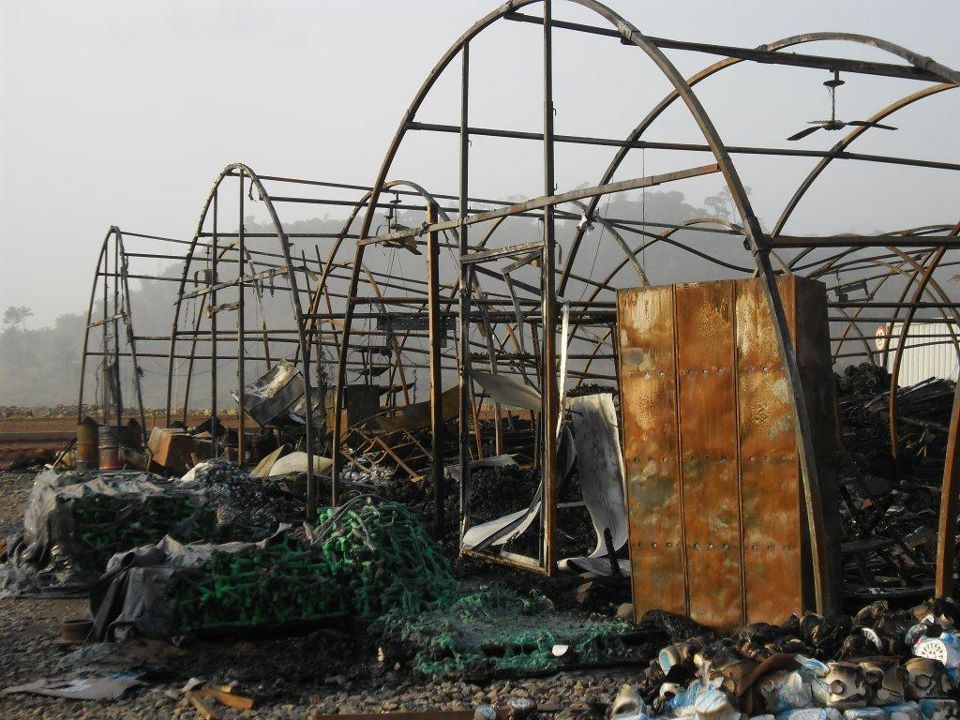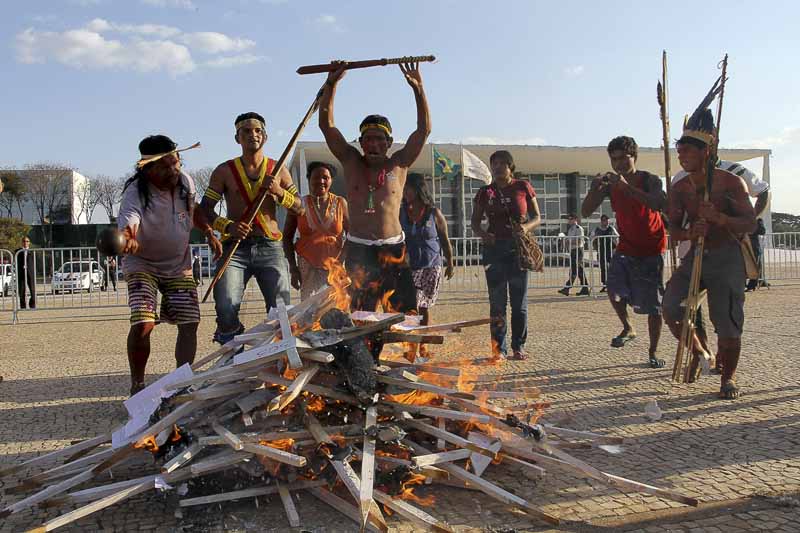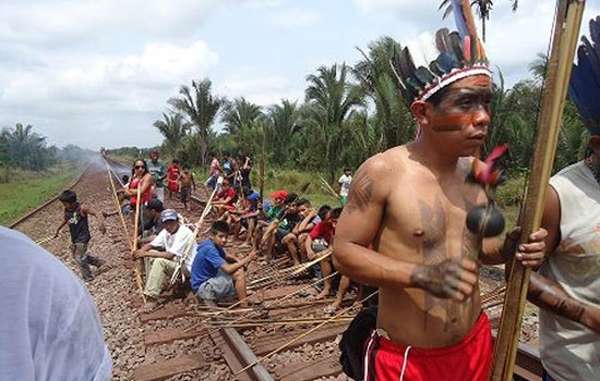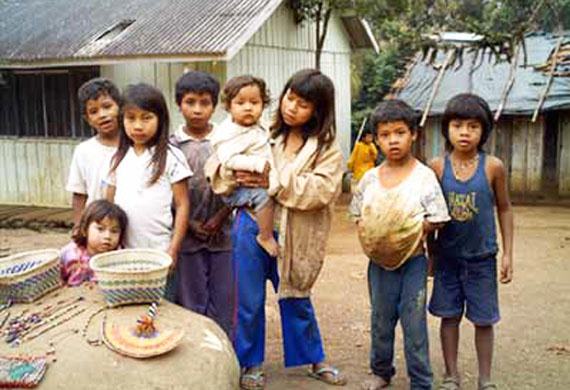
by Deep Green Resistance News Service | Nov 13, 2012 | Indigenous Autonomy, Property & Material Destruction, Reclamation & Expropriation, Worker Exploitation
By Agence France-Presse
Work on Brazil’s controversial $13 billion Belo Monte mega-dam ground to a halt Monday after protesters torched buildings at three dam construction sites over the weekend, the developer said.
Saturday, “a group of 30 people set fire to prefab structures at the Pimental site. They went into the cafeteria, destroyed everything and robbed the till” before setting it ablaze, said Fernando Santana, spokesman for builders Consorcio Constructor Belo Monte (CCBM).
And late Sunday, groups of 20 people set structures ablaze at Canais and Diques, two other dam construction sites, said Santana.
“On Monday, as a precautionary security measure, all activities were suspended at the construction site,” said Santana, suggesting that “vandals” might be trying to derail salary renegotiation under way.
The state-owned Norte Energia hired CCBM to build the dam, which is set to be the world’s third largest when it has been completed. Between 12,000 and 13,000 workers would be employed at the site on two shifts, Santana said.
The incidents broke out after CCBM proposed a seven percent wage hike to the workers in an area where the inflation rate is at 30 percent, said Xingu Vivo, a non-governmental group opposing the dam.
On October 9 protesters — 150 natives and local fishermen — interrupted dam construction, accusing Norte Energia of backtracking on accords signed in June when people occupied the Pimental area for three weeks.
Indigenous groups fear the dam across the Xingu River, a tributary of the Amazon, will harm their way of life. Environmentalists have warned of deforestation, greenhouse gas emissions and irreparable damage to the ecosystem.
The dam is expected to flood some 500 square kilometers (200 square miles) along the Xingu and displace 16,000 people, according to the government, although some NGOs put the number at 40,000 displaced.
The natives want their lands demarcated and non-indigenous people removed from them, as well as a better healthcare system and access to drinking water.
Expected to produce 11,000 megawatts of electricity, the dam would be the third biggest in the world, after China’s Three Gorges facility and Brazil’s Itaipu Dam in the south.
It is one of several hydroelectric projects billed by Brazil as providing clean energy for a fast-growing economy.
“Avatar” director James Cameron and actress Sigourney Weaver support dam opponents, drawing parallels with the natives-versus-exploiters storyline of their blockbuster Hollywood movie.
From Bangkok Post: http://www.bangkokpost.com/news/world/320956/trouble-at-brazil-mega-dam-stops-construction-for-now

by Deep Green Resistance News Service | Oct 9, 2012 | Biodiversity & Habitat Destruction, Colonialism & Conquest, Indigenous Autonomy, Obstruction & Occupation
By Jeremy Hance / Mongabay
Construction on Brazil’s megadam, Belo Monte, has been halted again as around 150 demonstrators, most of them from nearby indigenous tribes, have occupied the main construction site at Pimental. Over a hundred indigenous people joined local fishermen who had been protesting the dam for 24 days straight. Indigenous people and local fishermen say the dam will devastate the Xingu River, upending their way of life.
“The renewed occupation of the project’s earthen cofferdams paralyzed construction works, while indigenous protestors seized the keys of trucks and tractors forcing workers to leave the strategic Pimental work camp on foot,” reads a press release from the NGO Amazon Watch. Around 900 workers were sent home.
This is the second occupation attempt in less than six months. Over the summer some 300 indigenous people sustained an occupation of the dam for 21 days, before breaking it off though little headway was made in talks with consortium building the dam, Norte Energia.
The Belo Monte dam, which would be the world’s third largest, has been plagued by controversy from its origin decades ago; the battle for the dam has been fought both in Brazil’s courts and on the international stage. If built, the dam will flood an estimated 40,000 hectares of present rainforest and could push some fish species to extinction. In addition, 16,000 people will be displaced according to the government, though some NGOs say the number is more likely double that.
Despite the impacts, the dam has been strongly supported by Brazilian President Dilma Rousseff, and every legal injunction against the dam has been overturned. Norte Energia has filed with a local court for repossession of the construction sties.
Indigenous groups say the construction of the dam is already imperiling their way of life, as the Xingu river becomes more difficult to navigate. They have also said they have no intention of leaving until Norte Energia meets their demands.
“We are witnessing the devastation of this land. The island of Pimental was completely destroyed, with a sole tree left standing, and the water is putrid. It is very shocking,” an protestor told Amazon Watch.
Dams are often described as ‘green’ energy source, however in the tropics they actually release significant methane emissions due to rotting vegetation. Although it has a shorter life than carbon, methane is a far more potent greenhouse gas.
From Mongabay: “Indigenous groups re-occupy Belo Monte dam in the Amazon“

by Deep Green Resistance News Service | Oct 6, 2012 | Colonialism & Conquest, Indigenous Autonomy, Mining & Drilling, Obstruction & Occupation
By Survival International
A protest involving Earth’s most threatened tribe, the Awá, has forced the world’s largest iron ore mine to suspend operations along its main railway line.
On Tuesday, hundreds of Indians including the Awá, took to the tracks of Vale’s Carajás railway to voice their opposition to Brazilian government plans that could weaken their land rights, if legalized.
The demonstration follows months of anger surrounding a draft text called Directive 303, which prohibits the expansion of indigenous territories.
The government has refused to scrap the proposed directive, despite it violating national and international laws by suggesting certain projects can be carried out on Indian land without proper consultation.
Frustrations spilled over on Tuesday, with several different tribes uniting to demand that their land rights are respected.
The blockade is the latest in a string of controversies to involve mining giant Vale, whose railway borders the territory of the Awá.
Last month, a judge reversed a ruling that had stopped the company from doubling its railway line to increase production.
The decision was a blow for the Awá, who blame the railway for bringing thousands of invaders into their lands and scaring off the animals they hunt.
Survival’s Director Stephen Corry said today, ‘If Brazil wants to lead the way and show the world that it respects its indigenous peoples, it should not be entertaining the harmful propositions of a handful of rural lobbyists. This protest shows that for tribes like the Awá, land rights are make or break.’
From Survival International: http://www.survivalinternational.org/news/8722

by Deep Green Resistance News Service | Sep 4, 2012 | Colonialism & Conquest, Indigenous Autonomy
By Inter-Press Service
The land conflict between the Guaraní-Kaiowá indigenous people and large landowners in the southwestern Brazilian state of Mato Grosso do Sul is a powder keg ready to explode, say observers.
Nísio Gomes, Jenivaldo Vera, Rolindo Vera, Teodoro Ricardi, Ortiz and Xurete Lopes are just a few of the names on a long list of people murdered in this state in recent years, according to the Indigenous Missionary Council (CIMI).
The statistics gathered by the Council, founded in 1972 by the Brazilian National Bishops’ Conference, reveal that 279 indigenous people have been killed since 2003 in land disputes with landowners and ranchers.
The most recent case is that of Eduardo Pires, who disappeared on Aug. 10 when armed men attacked a group of Kaiowá people in the Arroio Korá indigenous reserve, located in the municipality of Paranhos in the south of the state, near the border with Paraguay.
Arroio Korá, an area of roughly 7,000 hectares, was officially recognized as indigenous land on Dec. 21, 2009 by then president Luiz Inácio Lula da Silva. But one week later, a Federal Supreme Court ruling on an appeal filed by a landowner exempted a 184-hectare section of the land from this status.
“Even with this partial embargo, the government did not foresee that the rest would be effectively turned over to the Guaraní-Kaiowá,” said Flávio Machado, the CIMI regional coordinator in Mato Grosso do Sul. “The community, which is made up of around 600 members, currently occupies around 700 hectares. When they decided to retake control over the rest of the land, they met with a violent response,” he told Tierramérica*.
According to Eliseu, a Kaiowá leader who was present when the attack took place, on the morning of Aug. 10 some 400 members of the community set up a camp on a section of the officially recognised reserve land where a ranch is located.
A short time later, a number of armed men arrived. “I heard the gunshots and took off running. We are a people with a culture of peace, we have no weapons, but we are not going to give up fighting for our land. If we are going to die, we would rather die on our own land,” he told Tierramérica.
No one has seen Eduardo Pires since the attack. “I believe he is dead,” said Eliseu.
The Federal Police of Mato Grosso do Sul are in charge of the case. “The indigenous people say that one of them is missing. We are investigating, but we have nothing concrete. We have to be impartial,” Federal Police Superintendent Edgar Paulo Marcon commented to Tierramérica.
The following week, CIMI reports, the police removed a number of ranchers and their cattle from the area. Since then, the Kaiowá have been targeted by threats, the most explicit of which is a filmed declaration by Luis Carlos da Silva Vieira, known as Lenço Preto (“Black Kerchief”), posted on YouTube.
“We are going to organize and prepare for confrontation…They only want the land to be bothersome. We have weapons. If they want war, they’ll get war,” he states repeatedly.
In response, the Kaiowá community published a letter calling for urgent attention from the government. “Faced with a collective death threat, made publicly in the press by the landowners, we request an investigation and severe punishment of these promoters of the genocide/ethnocide of indigenous peoples.”
“Everyone knows that they have sophisticated and fearsome weapons, that they have money obtained at the expense of indigenous blood to buy more weapons and to hire gunmen… We do not have guns and, above all, we do not know how to use them,” the letter continues.
“We want to reiterate and highlight the fact that our fight for our ancestral lands is aimed solely at protecting human life and the fauna and flora of the planet Earth; it is not our intention to kill anyone.”
From Upside-Down World: http://upsidedownworld.org/main/brazil-archives-63/3844-brazil-landowners-declare-war-against-indigenous-guarani-kaiowa-in-mato-grosso-do-sul
by Deep Green Resistance News Service | Aug 28, 2012 | Colonialism & Conquest, Indigenous Autonomy
By Agence France-Presse
Brazil’s Supreme Court has approved the resumption of work on the huge Belo Monte dam in the Amazon, which was halted earlier this month after protests from indigenous groups.
The preliminary ruling on Monday overturns an earlier ruling that ordered construction of the dam across the Xingu River, a tributary of the Amazon, to be stopped until indigenous peoples can testify before Congress.
However, the decision by Supreme Court President Carlos Ayres Britto could be revised when the court examines the case further, its website said.
The dam, expected to produce 11,000 megawatts of electricity, would be the third-biggest in the world, after China’s Three Gorges facility and Brazil’s Itaipu dam in the south.
A regional federal court, in the earlier ruling, had noted that when Congress approved the project in 2005, it called for an environmental impact study after the start of the work.
By law, the native communities had the right to air their views in Congress on the basis of the study, but this was not done, the court said.
Work on the dam began a year ago, despite fierce opposition from local residents and green activists.
Indigenous groups fear the dam will harm their way of life while environmentalists have warned of deforestation, greenhouse gas emissions and irreparable damage to the ecosystem.
“Avatar” director James Cameron and actress Sigourney Weaver have given their backing to dam opponents, drawing parallels with the natives-versus-exploiters storyline of their blockbuster Hollywood movie.
Belo Monte is expected to flood an area of 500 square kilometers (200 square miles) along the Xingu, and displace 16,000 people, according to the government. Some NGOs estimate that 40,000 people would be displaced.
From Yahoo! News:




